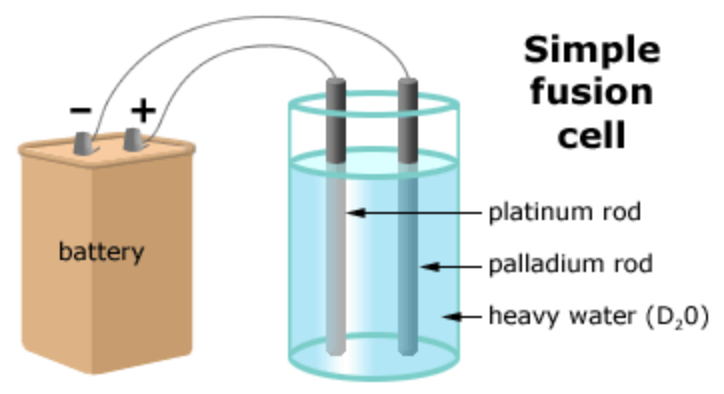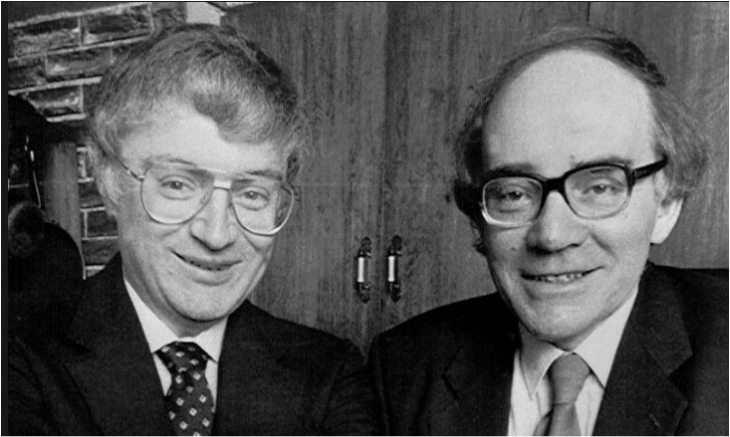|
Copyright R. Zamenhof, 2013.
 Pons and Fleischmann's simple fusion cell experiment for observing cold fusion. The platinum electrode absorbs the heavy hydrogen (deuterium) nuclei from the water bath and concentrates them so that their packing density in the platinum is enormously increased. This, together with the well-known "tunneling" effect, was believed to have produced fusion of the deuterium nuclei and raised the temperature of the water bath consistent with the existence of heavy-hydrogen fusion reactions. Introduction
In 1989, Dr. Stanley Pons (on the left in the photo above) and Dr. Martin Fleischmann (right), both at the University of Utah, shook the scientific world with the announcement that they had achieved cold fusion in their laboratory. At the time, Dr. Fleischmann was one of the world’s leading electrochemists. Cold fusion (if it in fact happens) occurs at “room” temperatures, as opposed to more classic, human-induced nuclear fusion that requires plasma temperatures of hundreds of millions of degrees Celsius, and presently is limited to occurring in special fusion devices such as TOKAMAKS or within fusion-based nuclear weapons. Nuclear fusion is the name given to a nuclear process in which light nuclei, such as deuterium (hydrogen nuclei with twice the mass of normal hydrogen consisting of a neutron and a proton), are forced together to create a single nucleus of a heavier element. In this case the heavier element is helium, consisting of two protons and two neutrons. Such fusion of light elements (below a mass number of 55 (which is Iron-55) causes a spontaneous release of net binding energy: specifically, the sum of the binding energies of the two pre-fusion nuclei minus the binding energy of the single, heavier post-fusion nucleus. Fusion—whether cold (i.e., at room temperature) or, more conventionally, hot (i.e., at temperature of hundreds of millions degrees C)-is only useful in terms of energy generation if it occurs between very light elements, i.e., of mass numbers generally less than 10. As the mass number of elements increases from 1 (hydrogen) to 55 (iron), fusion reactions having radiated energy as a byproduct can take place, but above mass numbers of around 10 their energy yield is greatly decreased. Fusion of two nuclei, each above a mass number of 55, theoretically produces no energy, so is not useful either for military or for civilian applications. Heavy nuclei (most commonly uranium-235 or plutonium-239) can only produce energy when they are broken apart—or fissioned. Nuclear Fusion: Military and Civilian Uses Normally, to initiate nuclear nuclear fusion reaction, two light nuclei must be forced together under conditions of extremely high mechanical pressure or extremely high temperature, since in the absence of these external factors, the mutual repulsion of nuclei due to their positively charged constituent protons prevents them from approaching each other closely enough to fuse. Military Uses of Fusion: Thermonuclear Bomb In the thermonuclear, or hydrogen bomb, the sum of the nuclear binding energies of two fusing nuclei of deuterium and tritium (which is hydrogen with one proton and two neutrons)--minus the binding energy of the resulting helium-4 nucleus, is released as a single pulse of 17.6 MeV ionizing energy, consisting of energetic protons, neutrons, and gamma rays. Why are fusion bombs so much preferred to uranium or plutonium fission bombs? If expressed on the basis of bang-per-unit-mass-of-explosive-material, a fusion reaction produces about 10 times more “bang” than a fission reaction. Civilian Uses of Fusion: Fusion Reactor In a fusion reactor (a not-yet-functioning technology), deuterium gas is initially electrically heated to hundreds of millions of degrees C, becoming a “plasma”, a mixture of nuclei and completely detached electrons. A powerful magnetic field is applied to the plasma to confine it within a restricted volume, where the vibration of the deuterium nuclei, due to their high temperature, supplies sufficient energy to cause some of them to overcome their mutual electrical repulsion and fuse together. After the initial plasma has been created--or “ignited”, to sustain the plasma creation process, some of the energy released as part of the fusion reactions is used to sustain the high temperature of the deuterium plasma and to power the magnetic field. The remainder of the energy released is used to generate heat and ultimately steam and electricity. Nuclear Fusion Reactions Deuterium, sometimes called heavy hydrogen, is symbolized as H2 or D. Each nucleus consists of one neutron (n) and one proton (p). He4* is the symbol for Helium-4 (sometimes referred to as an alpha particle) and the asterisk indicates when it is in an energetically excited state. Deuterium-deuterium (D-D) fusion is a two‐step process and can be summarized as follows: Step 1: D-D Fusion event occurs D + D > He4* He4* is created in a highly excited state Step 2: He4* immediately de-excites via three possible pathways 1) He4* > n + He3 + 3.27 MeV released as kinetic energy of n and He3 [50% likely] 2) He4* > p + H3 + 4.02 MeV released as kinetic energy of p and H3 [50% likely] 3) He4 * > He4 + 4.02 MeV released as kinetic energy of He4 [0.0001% likely] Note: no neutrons or tritium are produced in pathway 3 (see following comments) So, total energy released is [50% x 3.27]+[50% x 4.02]+[0.0001% x 4.02] = 3.64 MeV But only pathways 1) and 2) make significant contribution to D-D fusion energy release, since pathway 3) occurs only 1 in 1,000,000 times. Controversies Around Pons & Fleischmann’s Cold Fusion Experiment Pons and Fleischmann claimed that they had achieved cold fusion because of an observed rise in temperature of the heavy water bath used in their experiment (see next section for a brief description of the experimental setup). However, skeptics of these experiments have pointed out that if cold fusion had occurred, in addition to a rise in temperature of the heavy water bath, two other observations were necessary: First, through pathway 1) described above, the fusion reaction produces energetic neutrons. After the neutrons have been moderated (i.e., slowed down) by the small number of light hydrogen nuclei remaining in the heavy water bath, they are strongly absorbed by those same light hydrogen nuclei in nuclear reactions that produce 2.2 MeV gamma-rays. But nowhere close to the required number of 2.2 MeV gamma-rays has ever been measured in any cold fusion experiment. Second, through pathway 2) described above, the fusion reaction produces H3, or tritium nuclei. Now tritium is radioactive so its presence should be very easily measurable using fairly basic nuclear instrumentation. But once again, no tritium has ever been measured in the heavy water bath in any cold fusion experiment. Supporters of cold fusion, however, have defensive counter-arguments up their sleeve: Note, they point out, that if pathway 3) were the dominant one, significant amounts of neutrons or tritium would not be produced. But listen here, say the skeptics, the likelihood of pathway 3) being followed following a DD fusion event is only 1 in 1,000,000 compared to the other two pathways which are a million times more likely to occur. Aha, retort the cold fusion supporters, but what if, by some yet not understood mechanism unique to the room temperature fusion conditions, that third pathway did in fact become the dominant one; that would explain why very little tritium or 2.2 MeV gamma rays were observed. The logic is sound, except there is no evidence to support pathway 3) being more likely in cold vs. hot fusion. As a peripheral issue, if the temperature rise of the heavy water bath in Pons and Fleischmann’s experiment is used to compute the number of neutrons that should have been produced if cold fusion were responsible for their production, Pons and Fleischmann would be “ex-Pons and Fleischmann”, since the neutrons produced would have killed them. Experimental Setup of a Cold Fusion Experiment The experimental setup for observing cold fusion is remarkably straightforward. One starts with a water bath filled with heavy water. One places two metallic electrodes in the water bath, one of them made of platinum. The two electrodes are connected to a DC voltage source, the positive side of the circuit to the platinum electrode. Finally, one inserts a thermometer into the water bath to measure any rise in temperature. The experimental setup is shown in the second picture above. Platinum has the property of absorbing hydrogen atoms from water. When the hydrogen atoms have been absorbed by platinum they become much more densely packed than they would be in water or other organic substances. The likelihood that two particles combine is not only determined by their mutual proximity (enhanced by the platinum), but also by the “tunneling effect”. Tunneling occurs in situations where, for various physical reasons, two particles are prohibited from combining; such as, for example, two positively-charged hydrogen nuclei. But, due to the statistical nature of nuclear reactions, there is some finite likelihood, albeit exceedingly small, that the particles will in fact combine. This effect is referred to as tunneling. Tunneling is also the nuclear mechanism by which alpha particles are emitted from some very heavy nuclei such as uranium-235 or radon-222, despite such emission being prohibited by the balance of nuclear forces. Within the platinum electrode, even if the tunneling likelihood for DD fusion is extremely small, due to the sheer enormous number of hydrogen atoms present, the total number of DD reactions might, in absolute numbers, be substantial and could theoretically cause a measurable rise in the temperature of the water bath. That is the explanation provided by many supporters of cold fusion of how DD fusion can occur at room temperature. And, if under those innovative and poorly understood experimental conditions, pathway 3) became the dominant one, only very small amounts of 2.2 MeV gamma rays or tritium would be produced. If a rise in the temperature of the water bath in the cold fusion experiment were agreed as being the only marker of successful cold fusion, even that phenomenon has not been reliably demonstrated. Summary Following the cold fusion announcement, Dr. Pons became the chairman of the chemistry department at the University of Utah. Dr. Fleischmann passed away in 2012. Candace Gilet has suggested some rules and principles for the pursuit of honest science, which are listed below: 1) The scientific community is responsible for checking the work of community members. Through the scrutiny of this community, science corrects itself. 2) Scientists actively seek evidence to test their ideas. They strive to describe and perform the tests that would prove their ideas wrong and/or allow others to do so. 3) Scientists take into account all the available evidence when deciding whether to accept an idea or not, even if that means giving up a cherished hypothesis. 4) Science relies on a balance between skepticism and openness to new ideas. 5) Scientists often verify surprising results by attempting to replicate the experiment. 6) In science, discoveries and ideas must be verified with multiple lines of evidence. 7) Data require analysis and interpretation. Different scientists may interpret the same data in different ways. Unfortunately, Pons and Fleischmann eschewed many of the above before announcing their discovery of cold fusion. Despite everything said, there is a renewed research effort at many top universities, and a number of positive results are being reported. The current experimental data on cold fusion is, however, still "in the closet", a condition shared by a few other scientific research areas, such as radiation hormesis, where at low radiation dose levels, typically like those in diagnostic x-ray imaging, it has been demonstrated in a number of well designed experiments that cancer incidence in fact decreases. It would indeed be refreshing if the doors of all scientific "closets" could be thrown open, and the controversial data that emerge be analyzed objectively by respected scientists. Science would progress more rapidly to the benefit of us all. If during such a 21st century scientific enlightenment, cold fusion was concluded to be a reality, the implications for mankind would be staggering. As mentioned in the introduction, using the top 6 inches of water in Lake Superior as hydrogen fuel for cold fusion, the energy needs of our entire planet could be met for 100 years, and this energy would be much cleaner than what is currently available with coal, natural gas, or nuclear energy generation. The physicist Carl Sagan said it well: “Extraordinary claims require extraordinary proof.” So far, no compelling proof of the existence of cold fusion has emerged, but we should all keep open minds. |
About the Author Archives |
Live Chat Support
×
Connecting

You:
::content::
::agent_name::
::content::
::content::
::content::


 RSS Feed
RSS Feed